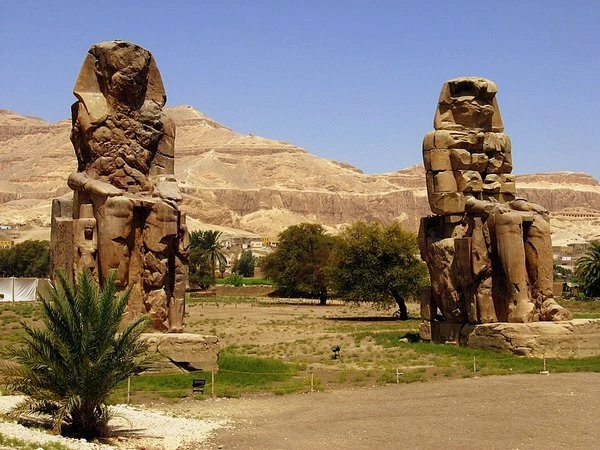

The Colossi of Memnon are two massive stone statues of Pharaoh Amenhotep III. For 3,400 years they have sat in the Theban necropolis, across the River Nile from the city of Luxor. History of the Colossi of Memnon
The original function of the Colossi was to stand guard at the entrance to Amenhotep's memorial temple (or mortuary temple): a massive cult center built during the pharaoh's lifetime, where he was worshipped as a god-on-earth both before and after his departure from this world.
In its day, this temple complex was the largest and most opulent in Egypt. Covering a total of 35 ha, even later rivals such as Ramesses II's Ramesseum or Ramesses III's Medinet Habu were unable to match it in area; even the Temple of Karnak, as it stood in Amenhotep's time, was smaller.
With the exception of the Colossi, however, very little remains today of Amenhotep's temple. Standing on the edge of the Nile floodplain, successive annual floods gnawed away at the foundations (a famous 1840s lithograph by David Roberts shows the Colossi surrounded by water) and it was not unknown for later rulers to dismantle and reuse portions of their predecessors' monuments.
The Greek geographer Strabo, writing in the early years of the 1st century, tells of an earthquake (in 27 BC) that shattered the northern colossus, collapsing it from the waist up. Following its rupture, this statue was then reputed to "sing" every morning at dawn: a light moaning or whistling, probably caused by rising temperatures and the evaporation of dew inside the porous rock.
The legend of the "Vocal Memnon", the luck that hearing it was reputed to bring, and the reputation of the statue's oracular powers, travelled the length of the known world, and a constant stream of visitors, including several Roman Emperors, came to marvel at the statues.
The mysterious vocalizations of the broken colossus ceased in 199 AD when Emperor Septimius Severus, in an attempt to curry favor with the oracle, reassembled the two shattered halves.
Memnon was a hero of the Trojan War, a King of Ethiopia who led his armies from Africa into Asia Minor to help defend the beleaguered city but was ultimately slain by Achilles. Whether associating the Colossi with his name was just whimsy or wishful thinking on the part of the Greeks – they generally referred to the entire Theban Necropolis as the "Memnonium" – the name has remained in common use for the past 2000 years.
Yes, it is a custom in Egypt as who works in tourism field expects a tip as an appreciation for the good service he offered.
Kindly refer to our Visa section in "About us" .
For the International flight it will be according to the type booking policy , & concerning the Internal flight you can have just 1 piece with maximum of 20 kilograms (international dimensions).
This depends on the carrier & its policy.

